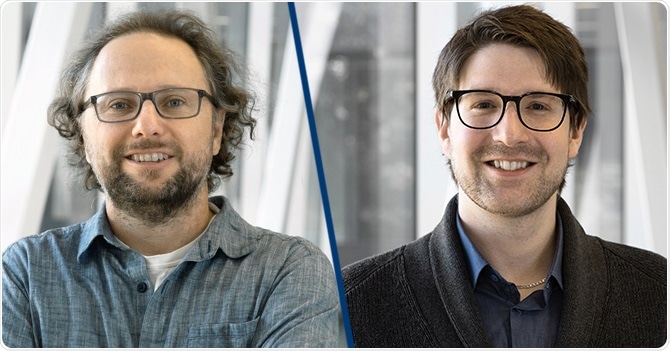At CRCHUM, a team of researchers has demonstrated that the aging of cells, which safeguards against cancer, is dependent on a genomic instability mechanism that causes the disease.

Francis Rodier and Marc-Alexandre Olivier. Image Credit: CHUM 2021.
Researchers led by cancer researcher Francis Rodier, a professor from Université de Montréal, have shown, for the first time, that cellular senescence—which takes place when aging cells stop dividing—occurs due to irreversible damage to the genome and not just by telomere erosion. The research has been reported in Nucleic Acids Research.
This breakthrough is in contrast to the scientific model most extensively used in the last 15 years and based on a single concept: telomeres—caps found at the ends of chromosomes for protecting genetic information, erode with each cell division. If they turn too short, they instruct the cell to stop dividing, thus avoiding damage to its DNA. When the cell is made dormant, it enters senescence.
If this model should be valid, a single telomere’s inactivation should be enough to stimulate the senescence program. Rodier’s laboratory and several others had already noted that many dysfunctional telomeres were required.
What’s most surprising is that, before really entering senescence, the cells divide one last time. In fact, the cell division caused by telomere dysfunction is so unstable that it ends up creating genetic defects. Contrary to what was believed, senescent cells have an abnormal genome. That’s what we show in our study.”
Francis Rodier, Professor, Université de Montréal
Snapshots of the life of a cell
Rodier’s team realized such results by employing the advanced imaging equipment financially supported by the Institut du cancer de Montréal.
Genetically, we were able to reproduce the phenomenon of cellular aging in the laboratory and ensured that all the telomeres of a population of cells became dysfunctional. With our equipment, we then observed in real time what was happening inside each single cell.”
Marc-Alexandre Olivier, Study Co-First Author and PhD Student, CRCHUM
Another co-first author of the study is Olivier’s former colleague Sabrina Ghadaouia, who is currently pursuing postdoctoral studies in England.
As time passes, senescent cells accumulate in the body and result in the development of diseases like cancer. Thus, this study paves the way for new research opportunities.
For instance, is it possible to repair telomeres before the senescence phase, thus preventing cellular aging and genomic instability? Scientists have been debating this promising way for cellular rejuvenation for many years. However, the new therapeutic approaches still require fine-tuning.
Source:
Journal reference:
Ghadaouia, S., et al. (2021) Homologous recombination-mediated irreversible genome damage underlies telomere-induced senescence. Nucleic Acids Research. doi.org/10.1093/nar/gkab965.